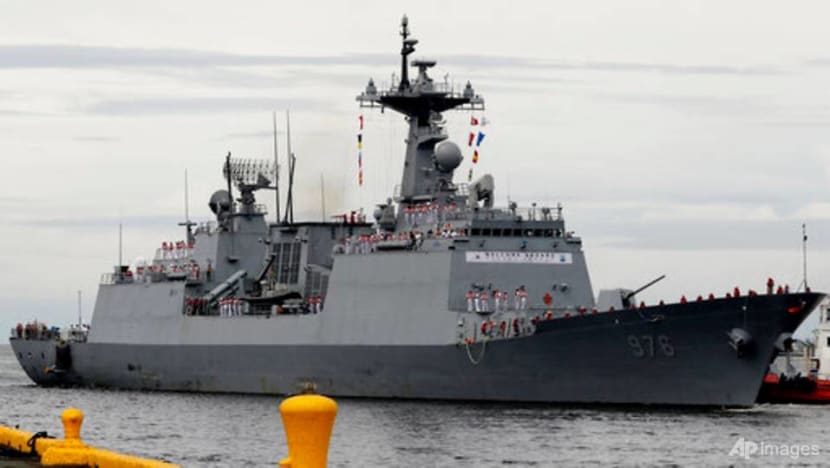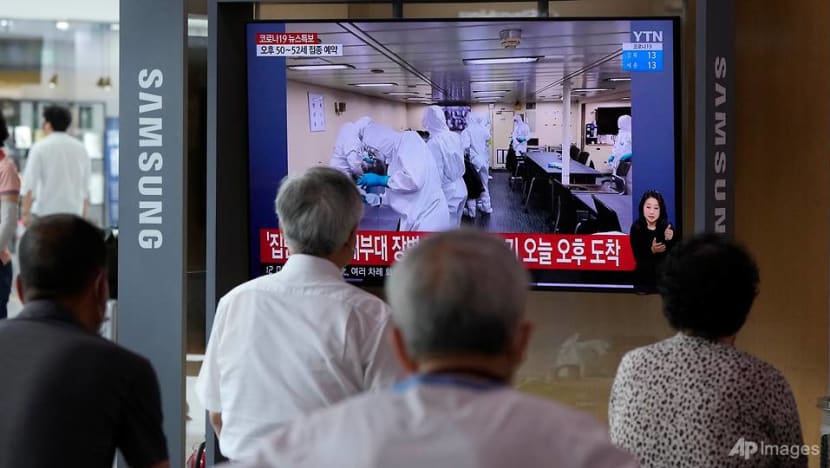Commentary: Managing COVID-19 risks on navy ships with small spaces is insanely challenging
An outbreak on a South Korean ship demonstrates the near-impossibility of containing an outbreak in confined places, says former navy man James Goldrick.

South Korean navy destroyer, the Munmu The Great, prepares to dock at the Manila South Harbor for a three-day port call off Manila, Philippines on Sep 2, 2019. (Photo: AP/Bullit Marquez)
CANBERRA: Ships and respiratory disease make bad partners. Confined spaces and internal ventilation systems mean that infections are practically impossible to contain once they get onboard.
The dangers of COVID-19 for a ship with an unvaccinated crew have just been starkly demonstrated in the South Korean destroyer Mun Mu Daewang. At least 247 out of 301 crew caught the infection in July though none have been reported to be critically ill.
The original crew have been flown back to South Korea from their deployment off East Africa and replaced en masse by fully vaccinated personnel.
The ship had been dispatched months earlier with the knowledge that its crew would be vulnerable. They were not vaccinated as the ship departed South Korea in February ahead of the country’s vaccine roll-out.
South Korean Defence Minister Suh Wook and other national leaders have apologised. With the power of 20/20 hindsight, whatever precautions the Republic of Korea Navy had put in place had clearly failed. A single failure in these circumstances can be irreparable.
READ: Commentary: TraceTogether and SafeEntry were never foolproof in averting recent fishery port and KTV clusters
VACCINATION THE BEST STRATEGY
Navies learnt this hard lesson during the Spanish flu pandemic which started in 1918, the last year of the World War I.
Operations were delayed or cancelled outright because so many were sick, while combatants struggled to ensure that essential work such as minesweeping and convoy protection could continue.

Many ships could not leave harbour for days and even weeks because of the number of sick personnel. At least one unit already at sea had so many crew members incapacitated that another ship had to be sent out to bring back the destroyer concerned.
Little has changed for navies from 1918 in dealing with COVID-19. Until all personnel have been vaccinated, the best, indeed the only approach navies can adopt to prevent infection and keep their ships operational is to isolate their crews from the outside world.
READ: Commentary: Questions arise over Indonesian military’s maintenance programmes after submarine sinking
HOW THE ROYAL AUSTRALIAN NAVY PARTICIPATED IN EXERCISE RIMPAC
Short of a COVID-19 vaccine however, navies, like the Royal Australian Navy, had adopted a stringent system to minimise the risk of spread so that operational taskings, particularly overseas deployments and major exercises could continue in 2020.
In July 2020, Australian ships sailed for that year’s regional presence deployment to join the United States’ led RIMPAC (Rim of the Pacific) exercise in Hawaiian waters.
Well before leaving Australia, the crews concerned went into onboard quarantine to ensure that all concerned were disease-free. This required careful monitoring of who from the shore was dealing with the ships and how, extending to how the embarkation of stores and equipment was managed, before departure.
Although much was done before quarantine was imposed, the reality is that defects develop in the course of the journey and during the exercise, and processes must be developed to allow urgent supplies to be brought onboard without breaching quarantine.

Once the Australian force sailed, unlike normal deployments, there were no port calls en route to Hawaii. But sometimes visitors are essential – such as harbour pilots as part of the exercise – and ways must be found to allow them to do their jobs without breaching quarantine
On the whole, COVID-19 control measures meant that many diplomatic and capacity-building activities associated with naval visits in the region could not take place. But it was a price that had to be paid if larger, strategic deployment goals were to be met: Achieving the invaluable operational training and improved interoperability with alliance partners that only a sophisticated major exercise like RIMPAC can provide.
The RIMPAC exercise itself was modified to reduce the number of shore-based personnel.
The Australian ships went on from Hawaiian waters to conduct other exercises in Southeast Asian waters before they returned home, some as late as October 2020, after more than three months away.
READ: Commentary: Noisy RSAF aircraft and annoyed residents - some compromises are needed
NAVIES DEALING WITH A POST-CORONAVIRUS FUTURE
Even in a post-coronavirus future, living with an endemic COVID-19 will impose some uncertainty. Navies will therefore need to find ways of balancing risk with their requirements even after vaccination programmes are complete around the world.
The vaccinated crew of the Queen Elizabeth experienced an outbreak of the disease at an early stage of their current carrier strike group deployment to the Indo-Pacific this year.
Being vaccinated meant that the effects seem to have been mild for the 100 or more involved, and mitigation measures can be a little more effective in such a big, minimally manned ship.
READ: Commentary: Submariners face huge challenges underwater - where there's no margin for error
Nevertheless, the presence of the infection means that the British aircraft carrier must have even less direct contact with countries in the regions it will be visiting than originally intended.
One problem shared by navies which maintain nuclear deterrent forces in the form of ballistic missile submarines is to ensure that these units are absolutely COVID-free before they embark on their extended, wholly covert patrols.
Surface forces and other submarines have much more flexibility than units committed to providing continuous at-sea nuclear deterrence. Hence, this latter group must have a quarantine regime and associated procedures that are even more rigorously enforced.
This does not come easy. Strictier pandemic measures have human costs, not only for the crew but their families. Quarantine requirements add to the time spent on deployment and reduce the time that naval personnel can be with their loved ones.
(Why not allow dining in for those vaccinated when MICE and other big events can continue? Public health experts discuss whether new rules mean prior plans to live normally with COVID-19 will shift on this week’s Heart of the Matter podcast.)
SEEING THE SEA RATHER THAN THE WORLD
The adage that one joins the navy to see the world has been overtaken by the embittered riposte of veterans – that all one sees is the sea.
Thus, when units of the Japanese, South Korean and American navies arrived in Sydney in July, ensuring their visit did not impose undue COVID risks meant that they could only experience Sydney from their ships. Their crews were only allowed onto the secured area around the wharves at which they were berthed.
With the extended periods on board, new ways have to be found to keep navy personnel fit and contented.
Overcoming a plethora of new challenges to maintain operational readiness in the face of a deadly pandemic is no mean feat. The truth is, however, that mastering COVID-19 globally will be as welcome for the navies of the world and their people as it will be for anyone.
BOOKMARK THIS: Our comprehensive coverage of the COVID-19 pandemic and its developments
Download our app or subscribe to our Telegram channel for the latest updates on the coronavirus outbreak: https://cna.asia/telegram
James Goldrick is an Adjunct Professor at the Strategic and Defence Studies Centre of the Australian National University. He retired from the Royal Australian Navy as a two-star Rear Admiral in 2012.














